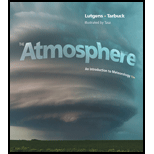
The Atmosphere: An Introduction to Meteorology (13th Edition) (MasteringMeteorology Series)
13th Edition
ISBN: 9780321984623
Author: Frederick K. Lutgens, Edward J. Tarbuck, Dennis G. Tasa
Publisher: PEARSON
expand_more
expand_more
format_list_bulleted
Question
Chapter 1, Problem 7GST
To determine
Whether the thickness of the troposphere would be greater over Hawaii or over Alaska, with a valid reason. Whether it is likely that the thickness of the troposphere over Alaska is different in January from in July and the reason for the same.
Expert Solution & Answer
Trending nowThis is a popular solution!

Students have asked these similar questions
EEZE
LETCHUP
ID
Draw the most likely conjugate base resulting from this acid-base reaction.
Include all lone pairs. Ignore inorganic byproducts.
Drawing
く
NaOCH2CH3
:0:
:0:
狗
Discussion Question: Ecosystems Essentials
A+
shof 1000
Exo-spil
The Human Denominator Assignment
As we learn about how the earth works, we learn to identify the different earth spheres
and how they overlap and affect one another. An understanding of the Earth's systems and
spheres takes practice. More importantly, we can see the "Domino Effect" of the spheres as they
interact with one another. We have learned that while endogenic processes are separate from
exogenic process, the lithosphere affects the atmosphere which affects the hydrosphere, and the
Answer
Chapter 1 Solutions
The Atmosphere: An Introduction to Meteorology (13th Edition) (MasteringMeteorology Series)
Ch. 1.1 - Prob. 1CCCh. 1.1 - Prob. 2CCCh. 1.1 - Prob. 3CCCh. 1.2 - Prob. 1CCCh. 1.2 - Prob. 2CCCh. 1.3 - Prob. 1CCCh. 1.3 - Prob. 2CCCh. 1.3 - Prob. 3CCCh. 1.3 - Prob. 4CCCh. 1.3 - Prob. 5CC
Ch. 1.4 - Prob. 1CCCh. 1.4 - Prob. 2CCCh. 1.4 - Prob. 3CCCh. 1.4 - Prob. 4CCCh. 1.5 - Prob. 1CCCh. 1.5 - Prob. 2CCCh. 1.5 - Prob. 3CCCh. 1.5 - Prob. 4CCCh. 1.5 - Prob. 5CCCh. 1.5 - Prob. 6CCCh. 1 - Prob. 1GSTCh. 1 - Prob. 2GSTCh. 1 - Prob. 3GSTCh. 1 - Prob. 7GSTCh. 1 - Prob. 4GSTCh. 1 - Prob. 5GSTCh. 1 - Prob. 8GSTCh. 1 - Prob. 1PCh. 1 - Prob. 2PCh. 1 - Prob. 3PCh. 1 - Prob. 4PCh. 1 - Prob. 5PCh. 1 - Prob. 6PCh. 1 - Prob. 7PCh. 1 - Prob. 8P
Knowledge Booster
Similar questions
- Answers with -1.828, -1.31 or 939.3 are not correct.arrow_forwardwhat is content analysis and what are the benefits and the negativesarrow_forward2. Provide a clear arrow-pushing mechanism for the following reactions. Do not skip proton transfers, do not combine steps, and make sure your arrows are clear enough to be interpreted without ambiguity. a. CH3 Ph OEt هد Ph CH3 Hint: the species on the left is an ynolate, which behaves a lot like an enolate.arrow_forward
- b. CH3 H3C CH3 CH3 H3C an unexpected product, containing a single 9- membered ring the expected product, containing two fused rings H3C-I (H3C)2CuLi an enolatearrow_forwardb. H3C CH3 1. 2. H3O+ H3C MgBr H3Carrow_forwardPredict the major products of this reaction: excess H+ NaOH ? A Note that the first reactant is used in excess, that is, there is much more of the first reactant than the second. If there won't be any products, just check the box under the drawing area instead. Explanation Check Click and drag to start drawing a structure. © 2025 McGraw Hill LLC. All Rights Reserved. Terms of Use Privarrow_forward
- 1. For each of the reaction "railroads" below, you are either asked to give the structure(s) of the starting material(s) or product(s), or provide reagents/conditions to accomplish the transformation, as indicated by the boxes. a. NaOMe H+ .CO,H HO₂C MeOH (excess) MeOH H3C Br يع CH3 1. LiAlH4 2. H3O+ 3. PBг3 H3C 1. Et-Li 2. H3O+ -CO₂Me -CO₂Me OH CH3 CH3 ল CH3arrow_forwardPredict the intermediate 1 and final product 2 of this organic reaction: NaOMe ག1, ད།་, - + H You can draw 1 and 2 in any arrangement you like. 2 work up Note: if either 1 or 2 consists of a pair of enantiomers, just draw one structure using line bonds instead of 3D (dash and wedge) bonds at the chiral center. Explanation Check Click and drag to start drawing a structure. Х © 2025 McGraw Hill LLC. All Rights Reserved. Terms of Use | Parrow_forwardI need help with part c and darrow_forward
- Three slits, each separated from its neighbor by d = 0.06 mm, are illuminated by a coherent light source of wavelength 550 nm. The slits are extremely narrow. A screen is located L = 2.5 m from the slits. The intensity on the centerline is 0.05 W. Consider a location on the screen x = 1.72 cm from the centerline. a) Draw the phasors, according to the phasor model for the addition of harmonic waves, appropriate for this location. b) From the phasor diagram, calculate the intensity of light at this location.arrow_forwardI need help with tracing over part A can someone help me outarrow_forwardA Jamin interferometer is a device for measuring or for comparing the indices of refraction of gases. A beam of monochromatic light is split into two parts, each of which is directed along the axis of a separate cylindrical tube before being recombined into a single beam that is viewed through a telescope. Suppose we are given the following, • Length of each tube is L = 0.4 m. • λ= 598 nm. Both tubes are initially evacuated, and constructive interference is observed in the center of the field of view. As air is slowly let into one of the tubes, the central field of view changes dark and back to bright a total of 198 times. (a) What is the index of refraction for air? (b) If the fringes can be counted to ±0.25 fringe, where one fringe is equivalent to one complete cycle of intensity variation at the center of the field of view, to what accuracy can the index of refraction of air be determined by this experiment?arrow_forward
arrow_back_ios
SEE MORE QUESTIONS
arrow_forward_ios